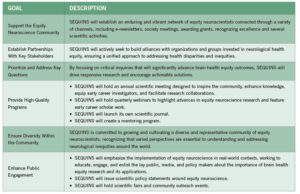An introduction to the Society for Equity Neuroscience (SEQUINS).
By Raelle Tagge, Lilyana Amezcua, and Bruce Ovbiagele

Lilyana Amezcua, Bruce Ovbiagele and Raelle Tagge
Neurological conditions are now the most prominent cause of ill health and infirmity worldwide.1 This sobering development occurs in a setting where the global burden of neurological disease is unevenly distributed, disproportionately impacting certain minority ethnic and racial backgrounds, as well as those from lower socioeconomic groups or residing in medically underserved regions. These neurological disparities are anticipated to get worse with time. Bending the neurological disparities curve successfully and sustainably will require a sense of urgency, focus, commitment, community, and rigor.2
Founded in 2024, the Society for Equity Neuroscience (SEQUINS) is dedicated to enhancing equitable neurological care and outcomes via research.3 SEQUINS aims to establish an enduring multidisciplinary academic community focused on advancing the emerging field of equity neuroscience. It also:
- explores the multifaceted basis for various neurological inequities and disparities
- tests promising interventions
- fosters the careers of equity neuroscientists across all stages
- partners with aligned organizations for universal impact.3
SEQUINS is led by a board comprised of a multidisciplinary, multisectoral, multinational, and multicultural group of seasoned scientists and leaders covering neurology, psychiatry, basic/translational neuroscience, epidemiology, and health services research. With a mission to advance brain health equity through science, SEQUINS has a number of key goals. (See Table 1.)
On May 15, 2025, SEQUINS will hold its inaugural annual scientific meeting in Charleston, South Carolina. The meeting will be a one-day multidisciplinary forum, which will include state-of-the-art scientific lectures, early career presentations, early career development sessions, recognition of excellence in equity neuroscience (Hall of Fame) and mentoring of scientists (awards). There will also be celebrations of graduates from training programs, briefings by research funding agencies, and opportunities to network.
SEQUINS 2025 will offer a hybrid format with in-person and virtual options. In 2025, SEQUINS will also launch its own journal, Equity Neuroscience (EQN), published by Elsevier. It will be a peer-reviewed, open-access journal dedicated to publishing research that seeks to understand and address neurological inequities and disparities based on sex, race/ethnicity, geography, socioeconomic status, and other social determinants of health. SEQUINS also plans to establish a podcast titled “No Brain Behind” which will interview key scientists, leaders, and policy makers.
By seeking to narrow the differences between the world’s brain health haves and have-nots, SEQUINS looks forward to being a part of the solution to improving brain health globally.4,5 Clearly, SEQUINS cannot do this alone. As such, we are already members of the World Health Organization Civil Society Commission, International Brain Research Organization, and World Hypertension League.
SEQUINS is also establishing partnerships with the International Science Council, American Neurological Association, American Brain Foundation, Society for Neuroscience, Association of University Professors of Neurology, Clinical Neurological Society of America, National Institute of Neurological Disorders and Stroke, and Global Brain Health Institute. We plan to identify and partner with more organizations and institutions to help deliver high-quality scientific evidence to guide the implementation and dissemination of communications, policies, and programs toward the elimination of brain health inequities.
To learn more about SEQUINS and how you can contribute to the mission of promoting brain health equity through science, visit the SEQUINS website or contact them at info@s-equi-ns.org. Together, we can create a future where optimal neurological health is accessible to and equitable for all. •

Table 1. Key goals of SEQUINS.
Raelle Tagge is chief program officer of the Society for Equity Neuroscience as well as a research manager at the Northern California Institute for Research and Education. Lilyana Amezcua is vice president of the Society for Equity Neuroscience and associate professor of neurology and division chief for neuroimmunology and multiple sclerosis at the University of Southern California. Bruce Ovbiagele is president of the Society for Equity Neuroscience as well as professor of neurology and associate dean at the University of California, San Francisco.
Editors’ Note: SEQUINS is a newly founded U.S.-based society. It has no formal links with the WFN.
References:
1. GBD 2021 Nervous System Disorders Collaborators. Global, regional, and national burden of disorders affecting the nervous system, 1990-2021: a systematic analysis for the Global Burden of Disease Study 2021. Lancet Neurol. 2024;23(4):344-381.
2. The Lancet Neurology. Improving access to medicines for neurological disorders. Lancet Neurol. 2024;23(10):951.
3. Ovbiagele B. A proposal for equity neuroscience. Lancet Neurol. 2024;23(9):862-863.
4. Winkler AS, Gupta S, Patel V, Bhebhe A, Fleury A, Aukrust CG, Dua T, Welte TM, Chakraborty S, Park KB. Global brain health-the time to act is now. Lancet Glob Health. 2024;12(5):e735-e736.
5. Grisold W, Dodick DW, Guekht A, Lewis SL, Wijeratne T. World Brain Day 2024: a focus on brain health and prevention. Lancet Neurol. 2024;23(9):863-864.
